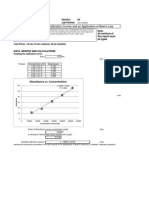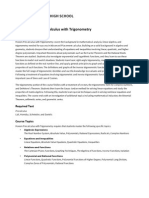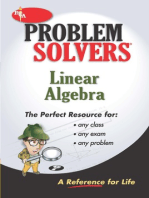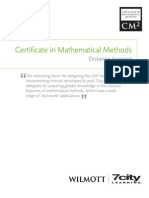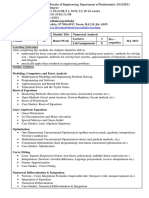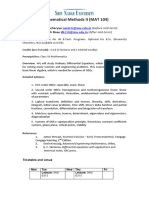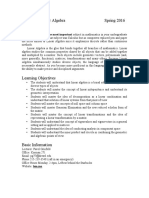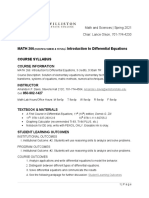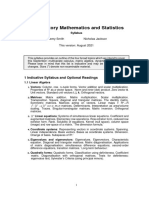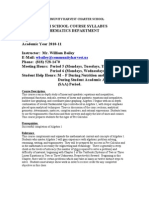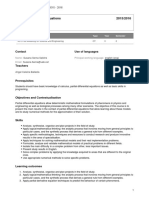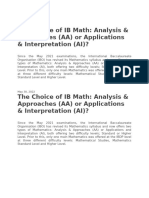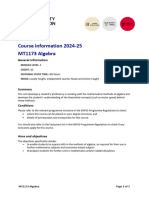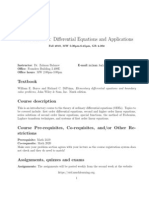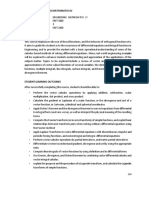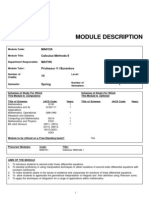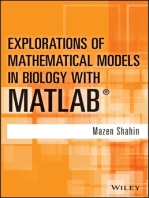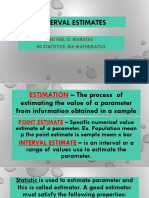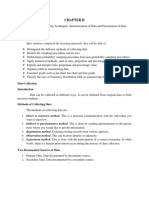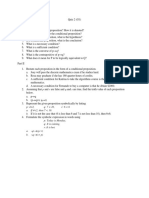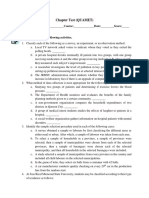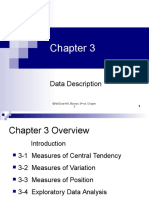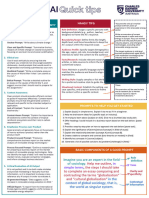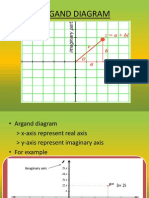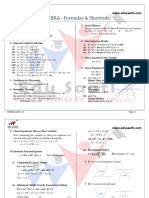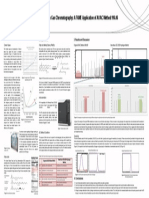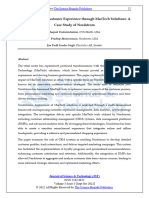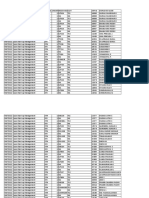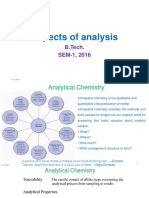Instructor ED NEIL O. MARATAS, Instructor, Math & Statistics
Instructor ED NEIL O. MARATAS, Instructor, Math & Statistics
Uploaded by
edniel maratasCopyright:
Available Formats
Instructor ED NEIL O. MARATAS, Instructor, Math & Statistics
Instructor ED NEIL O. MARATAS, Instructor, Math & Statistics
Uploaded by
edniel maratasOriginal Description:
Original Title
Copyright
Available Formats
Share this document
Did you find this document useful?
Is this content inappropriate?
Copyright:
Available Formats
Instructor ED NEIL O. MARATAS, Instructor, Math & Statistics
Instructor ED NEIL O. MARATAS, Instructor, Math & Statistics
Uploaded by
edniel maratasCopyright:
Available Formats
Differential Equations
Second Semester, Course Syllabus
JRMSU MAIN CAMPUS
Instructor
ED NEIL O. MARATAS, Instructor, Math & Statistics
College of Arts and Sciences
Email add: ednielmaratas@gmail.com
Text References:
Differential Equations with Boundary-Value Problems, seventh edition. Dennis G. Zill,
Michael R Cullen. Copyright 2009, Brooks/Cole. ISBN-13: 978-0-495-10836-8 (required) •
Differential Equations with Boundary-Value Problems Student Solutions Manual. Warren S.
Wright, Dennis G. Zill, Carol D. Wright. Copyright 2009, Brooks/Cole Publishing Company.
ISBN 978-0-495-38316-1. (Optional).
Course Description
Differential Equations, begins with some definitions and terminology and mathematical
models used in a differential equations course. First-order and higher-order differential equations,
along with the methods of solutions and their applications are introduced. Modeling with higher-
order, Laplace transform, and systems of linear first-order differential equations are covered. At
the end, students learn series solutions of linear equations. Numerical methods are covered
throughout the course.
Applicable toward graduation where program structure permits.
• Group requirement: Mathematics
• Area of Concentration: Mathematics.
The course must cover linear equations of the first order; linear equations with constant
coefficients; the general linear equation; variation of parameters; undetermined coefficients; linear
independence; the Wronskian; exact equations; separation of variables; and applications. In
addition, the course must cover at least two or three of the following topics: systems of linear
differential equations; solution of Laplace transforms; existence and uniqueness of solutions;
solution by power series; oscillation and comparison theorems; partial differential equations;
boundary value problems; numerical methods; and stability of solutions. Prerequisite: MTH 902,
Calculus II.
General Course Objectives:
While learning differential equations is certainly one of the goals of this course, it is not
the only objective. Upon completion of this course, the student should be able to ... • demonstrate
comprehension and understanding in the topics of the course through symbolic, numeric, and
graphic methods • demonstrate the use of proper mathematical notation • use technology when
appropriate and know the limitations of technology • work with others towards the completion of
a common goal • use deductive reasoning and critical thinking to solve problems.
Specific Course Objectives:
Upon completion of this course, the student should be able to ... • classify differential
equations by order, linearity, and homogeneity • solve first order linear differential equations •
solve linear equations with constant coefficients • use separation of variables to solve differential
equations • solve exact differential equations • use variation of parameters to solve differential
equations • use the method of undetermined coefficients to solve differential equations • determine
whether a system of functions is linearly independent using the Wronksian • model real-life
applications using differential equations • use power series to solve differential equations • use
Laplace transforms and their inverses to solve differential equations • solve systems of linear
differential equations using matrix techniques and eigenvalues • use numerical methods to solve
differential equations.
Type of Instruction:
Discussion, problem solving, student questions, student participation, oral presentations,
and lecture. Students are expected to read the material before coming to class and are strongly
encouraged to come to class with a list of questions and to ask these questions.
Method of Evaluation:
Could include any of the following: problem solving exams, objective exams, essays,
research papers, oral presentations, group projects, quizzes, homework.
Consideration may be given to such qualities as attendance, class participation,
attentiveness, attitude in class, and cooperation to produce the maximum learning situation for
everyone. The instructor will give you a grade sheet so that you can record your scores and keep
track of your progress in the course. If you are concerned about your grades, see the instructor.
Attendance Policy:
Regular attendance is essential for satisfactory completion of this course. Mathematics is a
cumulative subject and each day builds on the previous day's material. If you have excessive
absences, you cannot develop to your fullest potential in the course.
Technology:
In this course, we will concentrate on understanding the concepts of differential equations.
There will be instances when we will use the calculator or computer to aid in our understanding or
remove some of the tediousness of the calculations (especially in the area of numerical
approximations). There may be some projects, homework, or portions of a test that require you to
use technology to complete.
Topical Outline
Hours Topic
Introduction to Differential Equations
• Definitions and terminology
• Initial-value problems
• Differential equations as mathematical models
First-Order Differential Equations
• Solution curves without a solution; direction fields, autonomous first-order
differential equations
• Separation of variables
• Linear equations
• Exact equations
• Solutions by substitutions
• Numerical methods; Euler's method, numerical solvers
Modeling with First-Order Differential Equations
• Linear models; exponential growth and decay, Newton's law of cooling, mixture
problems, series circuits
• Non-linear models; logistic growth, chemical reactions
• Systems of differential equations; radioactive series, mixtures, predator-prey models,
competition models, networks
Higher-Order Differential Equations
• Linear differential equations; initial-value and boundary-value problems, homogenous
equations, non-homogeneous equations
• Reduction of order
• Homogenous linear equations with constant coefficients
• Undetermined coefficients; superposition approach, annihilator approach
• Variation of parameters
• Cauchy-Euler equation
• Solving systems on linear equations using elimination
• Non-linear differential equations
Modeling with Higher-Order Differential Equations
• Linear models with initial value problems; spring/mass systems with free undamped
motion, free damped motion, and driven motion; series circuit analogue
• Linear models with boundary value problems
• Nonlinear models
Series Solutions of Linear Equations
• Review of power series
• Solutions about ordinary points
• Solutions about singular points
• Special functions; Bessel's Equation, Legendre's Equation
The Laplace Transform
• Definition of the Laplace transform
• Inverse transforms and transforms of derivatives
• Operational properties of the transform; translations on the s-axis, translations on the
t-axis
• Derivatives of a transform, transforms of integrals,
• Transforms of periodic functions
• The Dirac Delta function
• Systems of linear differential equations
Systems of Linear First-Order Differential Equations
• Preliminary theory; superposition principle, general solutions
• Linear independence/dependence; Wronskian
• Homogenous linear systems; distinct real eigenvalues, repeated eigenvalues, complex
eigenvalues
• Nonhomogeneous linear systems; undetermined coefficients, variation of parameters
• Matrix exponentials
Numerical Solutions of Ordinary Differential Equations
• Euler's method
• Improved Euler's method
• Runga-Kutta methods (RK4)
You might also like
- Lab 3 - Calibration Curves and Beers LawDocument5 pagesLab 3 - Calibration Curves and Beers Lawapi-27247092275% (4)
- Online High School OM013: Honors Precalculus With TrigonometryDocument2 pagesOnline High School OM013: Honors Precalculus With TrigonometryJin SiclonNo ratings yet
- Maths MethodsDocument6 pagesMaths MethodssmaliraissianNo ratings yet
- Maths MethodsDocument6 pagesMaths MethodsTarek Fouda100% (1)
- ChE641A 201920I OutlineDocument3 pagesChE641A 201920I Outlineche 453No ratings yet
- Linear Algebra - SyllabusDocument4 pagesLinear Algebra - SyllabusmichacheNo ratings yet
- MTH3203 Differential Equations IDocument3 pagesMTH3203 Differential Equations IRonald EmanuelNo ratings yet
- Introduction To Differential EquationsDocument3 pagesIntroduction To Differential EquationsZarqa MiraniNo ratings yet
- MA1032 Syllabus 14S2Document2 pagesMA1032 Syllabus 14S2Ishan DewpuraNo ratings yet
- Math 313 Differential EquationsDocument2 pagesMath 313 Differential EquationsDennis ANo ratings yet
- UT Dallas Syllabus For Math4301.001.11f Taught by Wieslaw Krawcewicz (wzk091000)Document7 pagesUT Dallas Syllabus For Math4301.001.11f Taught by Wieslaw Krawcewicz (wzk091000)UT Dallas Provost's Technology GroupNo ratings yet
- Chapter00 IntroductionDocument19 pagesChapter00 Introductionakila IndurangaNo ratings yet
- F18XD Coure Outline and Assessment Methods, Deadlines - 2022-23Document4 pagesF18XD Coure Outline and Assessment Methods, Deadlines - 2022-23Tara PillayNo ratings yet
- Course Details Math Methods I IDocument3 pagesCourse Details Math Methods I IKirtik SinghNo ratings yet
- Maths 3rd Sem Syllabus @#Document7 pagesMaths 3rd Sem Syllabus @#Himanshi SharmaNo ratings yet
- Linear Algebra and Numerical ComputingDocument3 pagesLinear Algebra and Numerical ComputingAbdal ahmadNo ratings yet
- Calculus & Vectors Course Outline 2024-25-1Document3 pagesCalculus & Vectors Course Outline 2024-25-1bobNo ratings yet
- 2016 Fall Math 201 SyllabusDocument3 pages2016 Fall Math 201 SyllabusArvind Jared VishakNo ratings yet
- 930 AM Syllabus Math 266 - (15237W & 16083B & 17752L) TR Differential Equation Spring 2021Document7 pages930 AM Syllabus Math 266 - (15237W & 16083B & 17752L) TR Differential Equation Spring 2021Samantha OverendNo ratings yet
- Warwick Prerequisite MathsDocument4 pagesWarwick Prerequisite Mathsann2.nineNo ratings yet
- Course Outline (FEM 1023)Document2 pagesCourse Outline (FEM 1023)Ovinderjit SinghNo ratings yet
- Algebra Iab MXLDocument6 pagesAlgebra Iab MXLSNNo ratings yet
- Regional Math Olympaid How To StudyDocument2 pagesRegional Math Olympaid How To StudySudip799No ratings yet
- Differential Equation Course OutlinesDocument5 pagesDifferential Equation Course Outlinesalkheyr2002No ratings yet
- Ma149 15 2024Document4 pagesMa149 15 2024harrydan1235No ratings yet
- Course outline (1)Document5 pagesCourse outline (1)hanayetagesuNo ratings yet
- Revised Algebra 2 Syllabus 2010-11Document7 pagesRevised Algebra 2 Syllabus 2010-11FlyEngineerNo ratings yet
- Ram ProDocument27 pagesRam Proatharvajoshi23No ratings yet
- 21mat11 - Updated & Existing Syllabus - 30-10-2021Document4 pages21mat11 - Updated & Existing Syllabus - 30-10-2021Goutami T SunthankarNo ratings yet
- Math 122 Course SyllabusDocument4 pagesMath 122 Course Syllabusgrajojohndave1No ratings yet
- MATH 120-Linear Algebra With Differential Equations-Imran Naeem-Shaheen NazeerDocument4 pagesMATH 120-Linear Algebra With Differential Equations-Imran Naeem-Shaheen NazeerHaris AliNo ratings yet
- Discrete MathematicsDocument5 pagesDiscrete Mathematicsbeleagend98741No ratings yet
- MTH3202 Numerical MethodsDocument3 pagesMTH3202 Numerical MethodsRonald EmanuelNo ratings yet
- Week 0-Pt OrientationDocument35 pagesWeek 0-Pt OrientationFedee Clark Jarry AlisosoNo ratings yet
- LO - SCI 3530 Numerical Methods For Partial Differential EquationsDocument3 pagesLO - SCI 3530 Numerical Methods For Partial Differential Equationsa_minisoft2005No ratings yet
- Visvesvaraya Technological University, Belgaum: (X) - Bessel's Function of First (X) - LegendreDocument2 pagesVisvesvaraya Technological University, Belgaum: (X) - Bessel's Function of First (X) - LegendreJeevan Mj M JNo ratings yet
- MTH3104 Linear Algebra IIDocument2 pagesMTH3104 Linear Algebra IIRonald EmanuelNo ratings yet
- Ap Calculus Syllabus BCDocument4 pagesAp Calculus Syllabus BCapi-260695210No ratings yet
- Mathematical Methods in EngineeringDocument2 pagesMathematical Methods in EngineeringJagermeistNo ratings yet
- Math 2420 Syllabus SU 2013Document4 pagesMath 2420 Syllabus SU 2013SpoodieNo ratings yet
- PHAS0025 CourseOutlineDocument3 pagesPHAS0025 CourseOutlineo cNo ratings yet
- 2015/2016 Partial Differential Equations: Use of Languages ContactDocument4 pages2015/2016 Partial Differential Equations: Use of Languages ContactAnonymous Pz7BCG4No ratings yet
- Numerical Methods Course Outline Sep 2021Document3 pagesNumerical Methods Course Outline Sep 2021Abdiqani Mohamed AdanNo ratings yet
- Mathematics Analysis and Approaches and Applications and InterpretationsDocument6 pagesMathematics Analysis and Approaches and Applications and InterpretationsTakura DeraNo ratings yet
- BSC H Mathematics1styearDocument98 pagesBSC H Mathematics1styearbalad92538No ratings yet
- MT1173 AlgebraDocument3 pagesMT1173 AlgebraShirazNo ratings yet
- Math 110 SyllabusDocument4 pagesMath 110 Syllabusmapalonkoya07No ratings yet
- UT Dallas Syllabus For Math2420.501.10f Taught by Zalman Balanov (zxb105020)Document8 pagesUT Dallas Syllabus For Math2420.501.10f Taught by Zalman Balanov (zxb105020)UT Dallas Provost's Technology GroupNo ratings yet
- Syllabus Math 350 - sp12Document2 pagesSyllabus Math 350 - sp12Shouvik HalderNo ratings yet
- Proforma Mte 3110 - Linear AlgebraDocument3 pagesProforma Mte 3110 - Linear AlgebraMUHAMMAD RIDHUAN BIN HANAFINo ratings yet
- 5.4 Emt 3100 Engineering Mathematics IvDocument2 pages5.4 Emt 3100 Engineering Mathematics IvAmy AdamsNo ratings yet
- Mat5005 Advanced-Mathematical-Methods TH 1.0 40 Mat5005Document3 pagesMat5005 Advanced-Mathematical-Methods TH 1.0 40 Mat5005Abid YusufNo ratings yet
- Phy5001 - Mathematical-Physics - TH - 1.1 - 47 - Phy5001 - 59 AcpDocument2 pagesPhy5001 - Mathematical-Physics - TH - 1.1 - 47 - Phy5001 - 59 AcpHaze Subin CNo ratings yet
- Mechanical PG Syllabus Manufacturing Module 2019-20 (CBCS)Document41 pagesMechanical PG Syllabus Manufacturing Module 2019-20 (CBCS)abdulghaforNo ratings yet
- Mike Karls - Modeling First Approach in Traditional ODE CourseDocument41 pagesMike Karls - Modeling First Approach in Traditional ODE CourseeffendiNo ratings yet
- MA0124 - N Metric SpacesDocument3 pagesMA0124 - N Metric SpacesAjoy SharmaNo ratings yet
- 21mat11 2Document4 pages21mat11 2Fathima Syed MaqsoodNo ratings yet
- Stata: Do-Files and Log-FilesDocument4 pagesStata: Do-Files and Log-Filesedniel maratasNo ratings yet
- How To Analyse Data Using Anova in Ms ExcelDocument4 pagesHow To Analyse Data Using Anova in Ms Exceledniel maratasNo ratings yet
- Chapter ViiiDocument4 pagesChapter Viiiedniel maratasNo ratings yet
- Graphical Presentation: Ed Neil O. Maratas Instructor, JRMSU-Main BiostatisticsDocument34 pagesGraphical Presentation: Ed Neil O. Maratas Instructor, JRMSU-Main Biostatisticsedniel maratasNo ratings yet
- Interval Estimates: Ed Neil O. Maratas Bs Statistics, Ma MathematicsDocument10 pagesInterval Estimates: Ed Neil O. Maratas Bs Statistics, Ma Mathematicsedniel maratasNo ratings yet
- Tabular Method: Ed Neil O. Maratas, M.A. Instructor, Jrmsu BiostatisticsDocument21 pagesTabular Method: Ed Neil O. Maratas, M.A. Instructor, Jrmsu Biostatisticsedniel maratasNo ratings yet
- Chapter IIDocument16 pagesChapter IIedniel maratasNo ratings yet
- Chapter 1 Introduction To StatistcsDocument9 pagesChapter 1 Introduction To Statistcsedniel maratasNo ratings yet
- Applicationofbiostatistics 141230000032 Conversion Gate02Document75 pagesApplicationofbiostatistics 141230000032 Conversion Gate02edniel maratasNo ratings yet
- Trigonometric Functions: Ed Neil O. MaratasDocument79 pagesTrigonometric Functions: Ed Neil O. Maratasedniel maratasNo ratings yet
- Chapter TestmeasureofvariationDocument7 pagesChapter Testmeasureofvariationedniel maratasNo ratings yet
- After Students Completed The Learning Materials, They Will Be Able ToDocument10 pagesAfter Students Completed The Learning Materials, They Will Be Able Toedniel maratasNo ratings yet
- Redicates and UantifiersDocument44 pagesRedicates and Uantifiersedniel maratasNo ratings yet
- Quiz 2G1Document1 pageQuiz 2G1edniel maratasNo ratings yet
- QUAMETDocument5 pagesQUAMETedniel maratas100% (2)
- Answer Exercise 1. Output Is Naka Excel FileDocument4 pagesAnswer Exercise 1. Output Is Naka Excel Fileedniel maratas100% (1)
- Given The Learning Materials and Activities of This Chapter, They Will Be Able ToDocument14 pagesGiven The Learning Materials and Activities of This Chapter, They Will Be Able Toedniel maratasNo ratings yet
- Chapter 07Document20 pagesChapter 07Faye Noreen FabilaNo ratings yet
- Stats Chap03 BlumanDocument86 pagesStats Chap03 BlumanAnonymous IlzpPFINo ratings yet
- 4 5913720219091601321 PDFDocument447 pages4 5913720219091601321 PDFHarishNo ratings yet
- Big Data AssignmentDocument14 pagesBig Data AssignmentAlen AugustineNo ratings yet
- Two Tail Tests:: Accept The Null HypothesisDocument8 pagesTwo Tail Tests:: Accept The Null HypothesisAneelaMalikNo ratings yet
- Forecasting & Methods: CE G545 Airport Planning and DesignDocument23 pagesForecasting & Methods: CE G545 Airport Planning and DesignNavik BhandariNo ratings yet
- Prompt Engineering (Quick Tips)Document1 pagePrompt Engineering (Quick Tips)kandurimaruthiNo ratings yet
- Argand DiagramDocument6 pagesArgand DiagramNurAmierulNo ratings yet
- Reduced-Method Robustness Testing of Analytical Methods Driven by A Risk-Based Approach (Phil Borman Et Al., PharmTech, 2010) PDFDocument8 pagesReduced-Method Robustness Testing of Analytical Methods Driven by A Risk-Based Approach (Phil Borman Et Al., PharmTech, 2010) PDFMostafa AfifyNo ratings yet
- Bayesian Parameter EstimationDocument40 pagesBayesian Parameter EstimationWanjoli PaulNo ratings yet
- Approaches To DiscourseDocument26 pagesApproaches To Discoursenabeelajaved100% (1)
- Improving Plant Reliability by Risk Based InspectionsDocument20 pagesImproving Plant Reliability by Risk Based Inspectionsali zaenal abidin100% (2)
- Chapter 7Document24 pagesChapter 7Tegegn TeloNo ratings yet
- Function of Several VariablesDocument4 pagesFunction of Several VariablesKedhar Nadh GadiboinaNo ratings yet
- ProbabilityDocument145 pagesProbabilityNilesh Asnani100% (1)
- LP Chapter 4 Lesson 2 Point Estimation of The Population MeanDocument2 pagesLP Chapter 4 Lesson 2 Point Estimation of The Population MeanAldrin Dela Cruz0% (1)
- Analytical Chemistry I PDFDocument2 pagesAnalytical Chemistry I PDFIvana MaksimovicNo ratings yet
- Data Science Practical No 08Document4 pagesData Science Practical No 08Satyavan MestryNo ratings yet
- Differential EquationsDocument71 pagesDifferential EquationsSri DNo ratings yet
- Assessment 1 Marking Rubric HRMG 703 Semester 1 2021Document2 pagesAssessment 1 Marking Rubric HRMG 703 Semester 1 2021Dylan TaddumNo ratings yet
- Algebra Shorcuts Formulas For CAT - EDUSAATHIDocument12 pagesAlgebra Shorcuts Formulas For CAT - EDUSAATHITushar TikuNo ratings yet
- Differentiation From First PrinciplesDocument3 pagesDifferentiation From First Principleslixus mwangiNo ratings yet
- ACCT201 Corporate Reporting & Financial Analysis: Course Outline 2018/2019 Term 1Document4 pagesACCT201 Corporate Reporting & Financial Analysis: Course Outline 2018/2019 Term 1Hohoho134No ratings yet
- 625-10P FAME Application AOACDocument1 page625-10P FAME Application AOACSalvador GomezNo ratings yet
- Enhancing Retail Customer Experience Through Martech Solutions: A Case Study of NordstromDocument36 pagesEnhancing Retail Customer Experience Through Martech Solutions: A Case Study of Nordstromali79hasanpourNo ratings yet
- Classification & PredictionDocument78 pagesClassification & Predictionbiswanath dehuriNo ratings yet
- Fall 2021 - 22 Course Allocation ReportDocument117 pagesFall 2021 - 22 Course Allocation ReportSubarna LamsalNo ratings yet
- Aspects of Analysis PDFDocument61 pagesAspects of Analysis PDFKowla100% (1)
- Bloom's Taxonomy Interpreted For Mathematics: Lindsey ShorserDocument1 pageBloom's Taxonomy Interpreted For Mathematics: Lindsey ShorserasfddsfgsdgNo ratings yet
